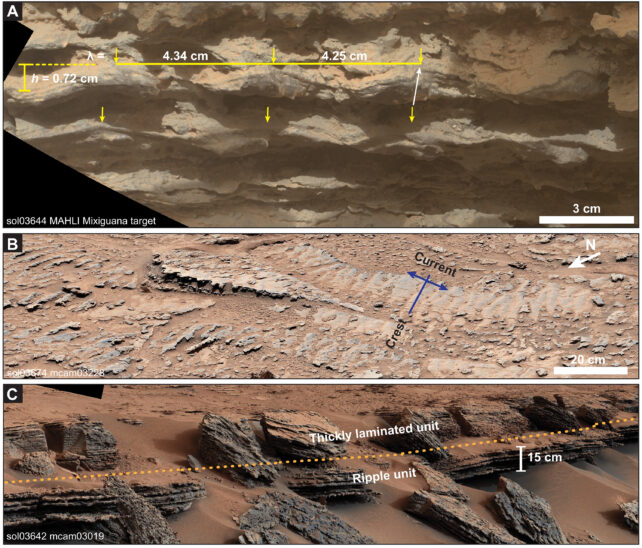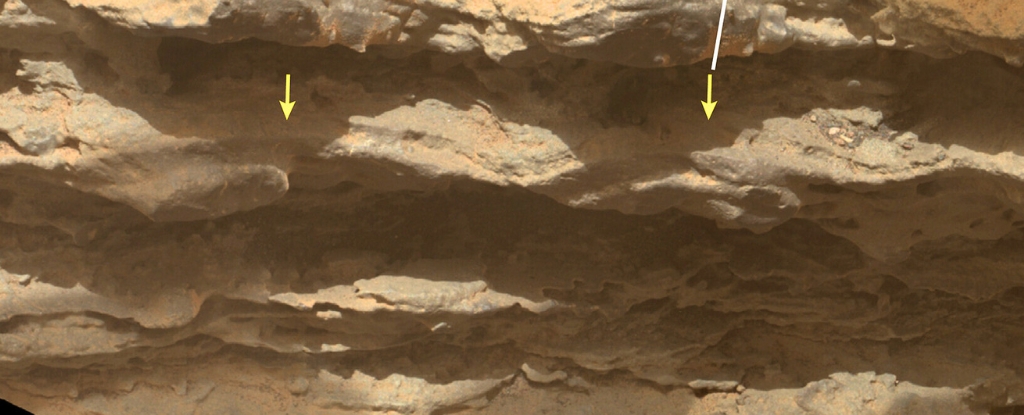Products You May Like
NASA’s Curiosity Rover has been exploring Mars since 2012 and more recently has found evidence of ice-free ancient ponds and lakes on the surface. The rover found small undulations like those seen in sandy lakebeds on Earth.
They would have been created by wind-driven water moving back and forth across the surface. The inescapable conclusion is that the water would have been open to the elements instead of being covered by ice. The discovery suggests the ripples formed 3.7 billion years ago.
Mars is the fourth planet in our Solar System and the second smallest of all the major planets. It’s known for its strong red colour which is caused by iron oxide in the surface material.

Classed as a terrestrial planet, Mars is similar in many ways to Earth, with valleys, volcanoes, and even evidence of dried-up river beds. The similarities end there, though, with polar caps made mostly of carbon dioxide ice, an unbreathable atmosphere, and a surface that is cold and dry.
It’s always held a special fascination for us due largely to vague hints through the centuries of alien intelligence, but more recently that it may have once been habitable.

One such rover that has been exploring the Martian landscape is the Curiosity Rover that was sent by NASA in 2011. It arrived at Mars in August 2012 and has been exploring the region around Gale Crater ever since.
The main objective of Curiosity is to investigate the climate and geology and to assess if they could have supported primitive life in the past.
To achieve that end, it’s equipped with an array of instruments, from drills to collect soil samples to cameras and instruments to analyse atmospheric samples.

In a paper recently published in the journal Science Advances by Caltech’s John Grotzinger, Harold Brown, Professor of Geology, and Michael Lamb, Professor of Geology, shared their findings.
They found two sets of what seem to be ancient wave ripples on the surface of Mars, now thought to be dried-up bodies of water with the ripples preserved in rock.
The ripples are tiny undulations and are often seen in beaches and lakebeds on Earth as wind-driven water flows across the shallows. The team is particularly excited that this means the water was not frozen and was once open to the elements as liquid.
The ripples discovered by Curiosity in Gale Crater are the strongest evidence to date that there have been bodies of liquid water in the history of the red planet. Analysis of the rocks and ripples suggests they formed 3.7 billion years ago.
It’s thought that the atmosphere and climate of Mars must have been far warmer than today and more dense. Dense enough to support liquid water in open air.

The team was able to create computer models from the ripples they found to attempt to discover the size of the lake. The size of the ripples and separation helps to determine how much water was present.
The ripple height of 6 mm and 4 to 5 cm separation tell us that the lake was shallow, possibly even less than 2 meters deep.
One of the sets of ripples known as the Prow outcrop was found in an area that was once wind-blown dunes. The other set was found nearby in the sulfate-rich Amapari Marker Band of rocks.
The two regions come from slightly different times, telling us that the warm, dense atmosphere occurred multiple times or at least for a long period of time.
The discovery has been a massive help to Mars paleoclimate studies that have tried to map the changing conditions on Mars.
NASA’s Opportunity rover was the first mission to discover ripples on the surface, but the nature of the bodies of water was uncertain.
This latest discovery has given a fascinating insight into the early conditions on Mars, with perhaps bodies of liquid dotted across the landscape. Further investigation is needed to see how commonplace the ripples are.
This article was originally published by Universe Today. Read the original article.
